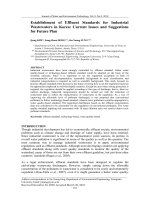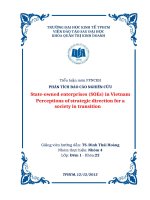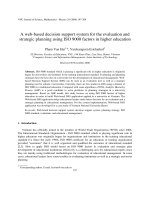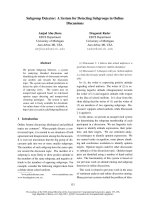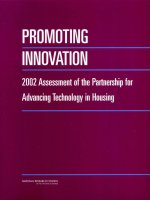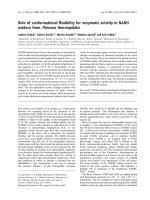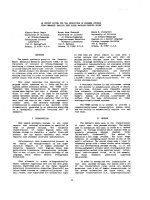Concept of expert system for modal split in transportation planning
Bạn đang xem bản rút gọn của tài liệu. Xem và tải ngay bản đầy đủ của tài liệu tại đây (832.23 KB, 18 trang )
Yugoslav Journal of Operations Research
16 (2006), Number 1, 107-124
CONCEPT OF EXPERT SYSTEM FOR MODAL SPLIT IN
TRANSPORTATION PLANNING
Maja M. POPOVIĆ, Jadranka J. JOVIĆ
Faculty of Transport and Traffic Engineering
University of Belgrade, Belgrade
Serbia and Montenegro
Received: October 2004 / Accepted: March 2005
Abstract: The objective of this paper is to develop a concept of expert system based on
the survey of experts' opinions and their experience concerning relations in modal split,
on the basis of parameters of transport system demand and transport supply, defined
through PT travel time and city size, i.e. mean trip length. This expert system could be of
use both to experts and less experienced planners who could apply the knowledge
contained in this expert system for further improvement, on operational as well as on
strategic level.
Keywords: Modal split, transport supply, transport demand, expert system.
INTRODUCTION
The expert system, created in this paper, has been envisaged as a tool to be used
on operational and strategic level in some segments of transport planning. The basic idea
for creating such an expert system was to define relations in modal split on the basis of
parameters of transport system demand and supply in one city.
To enable the use of this expert system on both strategic (planning) and
operational level, it is necessary to determine parameters which could be forecasted on
short-term and long-term basis. For planning purposes, such an expert system should
determine margins of share of specific transport modes. These limits should serve as
benchmarks in forecast of the relations in modal split during planning period, on the basis
of which, specific elements of future transport system are to be defined. In a similar
manner this expert system can be used for operational purposes, providing that survey of
parameter values is performed in the existing state or that a short-term forecast for these
parameters is made.
108
M.M. Popović, J.J. Jović / Concept of Expert System for Modal Split
As it is known [1] the basic parts of an expert system are the knowledge base
and a program which will make application of the knowledge base possible. In this case
the knowledge base has been created on the basis of an experts' opinions survey and on
the basis of past transport studies in the subject field. The process of a knowledge base
creation can be performed in the manner presented in Figure 1.
Figure 1: Block diagram of the process of knowledge base creation - EXSYMS
The first phase of knowledge base creation is represented by an analysis of the
existing transport studies. Characteristics of trip and modal split analyzed for Former
Yugoslavia cities can be presented in the scope of this phase.
The second phase comprises selection of relevant parameters of transport system
demand and supply. As a supply parameter, i.e. parameter of transport system quality, in
the first phase, it is recommended to select public transport travel time (tt), and the mean
trip length (Lmean), as a parameter for transport system users' demand.
The third phase represents definition of scenarios for modal split modelling.
These scenarios are being formulated by a combination of four values of mean trip length
M.M. Popović, J.J. Jović / Concept of Expert System for Modal Split
109
(Lmean and three values of the time spent outside vehicle (t1). The time spent outside
vehicle (t1) is a sum of the transfer time (ttr), approach time (tacc), waiting time (tw) and
terminating time (tter). In this phase travel time (tt) is replaced by the time spent outside
vehicle (t1). In this way twelve scenarios were formulated. Based on these 12 scenarios
the relations in the modal split were studied for three modes: PC-passenger car, PTpublic transport and OM-other modes (walking, bicycle, motorcycle, etc.)
In the fourth phase a survey of experts' opinions on modal split relations was
carried out. In the scope of this phase a study methodology was prepared and survey of
experts was performed.
The fifth phase includes the first part of the analysis of the obtained results, i.e.,
elaboration of the survey of experts' opinions applying prepared mathematical tests. This
results in interval evaluation of shares of defined modes, sample dispersion and mean
value of shares of defined modes. In addition, a processing of the obtained data was
performed.
Correction of the results obtained during survey of experts' opinions was carried
out in the sixth phase. These corrections were made in accordance with perceived
discrepancies and inconsistencies from the fifth phase.
After correcting these results, in the seventh phase, the EXSYMS Essential Base
(Expert System for Modal Split) was created. The Essential Base was provided when,
applying corrected survey results, regressive equations of dependence of specific
transport mode share upon the time spent outside vehicle (t1), as well as upon the mean
trip length (Lmean) were formulated.
In the next phase, the Essential Base was enlarged by correlating PT travel time
(tt) with the time spent outside vehicle (t1). In this way, by applying regression analysis,
dependence equations of specific transport mode share upon PT travel time (tt) were
provided.
In the last phase of creating the EXSYMS Base formed were range dependence
diagrams between share of PC, PT and OM, on the one hand and PT travel time, on the
other for various mean trip lengths (Lmean). After that, PT travel time (tt) was correlated to
parameters of PT operation (line network density in PT (σ) and, thus, the EXSYMS Base
was created.
The second part of the expert system, the programme for knowledge
application (inference engine), should be selected from a group of those programs which
are modelling a safe reasoning (in the function of the type of the subject problem, in each
phase, it selects a single rule from the set of valid rules), because the nature of the subject
problem is such that the queries raised in the expert system require a range solution.
Deduction and regression are to be applied as modes of reasoning. In some specific cases
this programme should enable providing responses to the following queries:
Assuming that transport supply parameter A has value "a" and transport demand
parameter B has value "b", what is proportional share of certain transport modes (PC,:PT,
OM); and
Assuming that percentages of transport mode share are PC = n%, PT=m% and
OM=r%, what are the values of transport supply A parameter and transport demand B
parameter?
This represents a description of the general concept of expert system for modal
split. For purposes of this paper, the phase representing creation of knowledge base of the
expert system was further elaborated.
M.M. Popović, J.J. Jović / Concept of Expert System for Modal Split
110
2. CREATION OF THE KNOWLEDGE BASE FOR THE EXSYMS EXPERT SYSTEM FOR MODAL SPLIT
The knowledge base for the concept of this expert system was created on the basis
of a study of previous transport surveys in Former Yugoslavia cities, as well as on the basis
of survey of experts' opinions with respect to relations in movement modal split in cities.
2.1. Selection of entry parameters for the expert system and definition of scenarios
Implementation of this expert system implies formulation of certain scenarios on
the basis of the selected (studied) parameters of transport system demand and supply,
which would enable definition of relations in movement modal split.
This means that for this expert system a modal split method has to be selected in
the first place. After that, it is necessary, among a large set of influential parameters, to
select parameters most adequately represent the current situation and prepare scenarios,
which should represent a combination of parameters of transport system supply and
demand by transport system users.
For modal split modelling a normative method was selected due to the fact that
past experience in Former Yugoslavia cities indicates that this mode was the most
frequent mode of modal split modelling in Former Yugoslavia region. Another reason for
such a choice was that this mode, by its nature, is dependent upon planners' (experts')
assessment. On the other hand, expert system creation implies formalization of the
models to be implemented into expert system. Consequently, by selection of normative
modelling this process is considerably simplified.
Selected parameters for creation of the knowledge base of expert system and for
defining scenarios of survey of experts' opinions on relations in modal split are: PT travel
time (tt) and city size expressed through mean trip length (Lmean).
The idea behind formulation of such scenarios was, from a number of selected
values during ride in PT and from the mean trip length, to make combinations (value
couples) for which relations in modal split are to be studied. Such scenarios are defined
for four values of mean trip length Lmean (km) and three values of travel time tt (min).
Based on the review of the transport surveys carried out in Former Yugoslavia
cities so far, as well as on the basis of recommendations of the experts in the field of
Transportation planning and traffic control, PT, etc., city size parameter, i.e., mean trip
length was defined as follows (Table 1):
Table 1: Dependence between mean trip length and city size
City size (number Mean trip length
Lmean (km)
of citizens)
50,000 to 100,000
2
100,000 to 200,000
3
200,000 to 500,000
4
over 500,000
8
Remarks
A city with undeveloped PT (or without PT) with commuter
transit having function of PT (Šabac, Užice, Valjevo,
Čačak, etc.)
A city with mainly one PT subsystem and commuter transit
(Subotica, Podgorica, Kragujevac, etc.)
A city with developed PT (one or two subsystems of PT)
and commuter transit (Novi Sad, Niš)
A big city having more PT subsystems (bus, tramway,
trolleybus, etc.), as well as developed commuter transit
(Belgrade)
M.M. Popović, J.J. Jović / Concept of Expert System for Modal Split
111
Travel time is a transport system quality parameter. In the process of travelling
a series of difficulties are piling up for a user. The travelling benefits are realized only
upon satisfying trip purpose at the end of a trip. Measurement of unattractiveness or
attractiveness toward a specific form of transport in the scope of one transport system is
made possible by comparing all inconveniences and benefits from the realized purpose.
The time spent in transportation for the users of transport system is time lost, i.e. "cost",
not only in terms of transport fare, but also in reference to "generalized costs" arising
from a series of, for a user, undesirable circumstances in the course of operation of
transport.
PT travel time (tt), as one of the characteristics of a journey, is a complex
indicator. It includes the following:
• Time of access to a system (tacc) (time needed from the "door" to station/stop),
• Waiting time of (tw),
• Riding time (time spent in a vehicle) (tr),
• Transfer time (ttr), and
• Terminating time (tter) (time needed from the last station/stop to the "door").
PT travel time comprises some of the essential transport supply parameters, such as:
• PT network density (as a supply indicator) – denser network ⇒ bigger
accessibility ⇒ shorter access time ⇒ shorter riding time,
• Number of vehicles on one line is included into time intervals, upon which
waiting time is depending. Therefore, both number of vehicles and time interval
are presented through waiting time – more vehicles ⇒ shorter time intervals ⇒
shorter waiting time.
For this reason, in this expert system concept, transport supply was defined in terms of
the PT travel time tt. PT travel time tt was specified as dependence upon the riding time tr
and upon the time spent outside vehicle t1, i.e., the sum of other components of time
travel (access time (tacc) + waiting time (tw) + transfer time (ttr)+ terminating time (tter).
The time spent outside vehicle t1 is provided in three options:
• t1= 10 minutes - "pink option"
• t1= 20 minutes - "grey option"
• t1= 30 minutes - "black option"
Time spent in a vehicle (tr) is given for each city size (mean trip length). Value of the
time spent in a vehicle is calculated for PT operating speed v=15 km/h. This speed value
is assumed on the basis of average PT operating speed [2].
o Time spent in a vehicle for a city with mean trip
length Lmean= 7 km is
tt= 28 min
o Time spent in a vehicle for a city with mean trip
length Lmean = 4 km is
tt=16 min
o Time spent in a vehicle for a city with mean trip
length Lmean = 3 km is
tt =12 min
o Time spent in a vehicle for a city with mean trip
length Lmean = 2 km is
tt =8 min
By combining these values, twelve scenarios for determining relations in modal
split for three modes of transport – PC, PT and OM - were defined. Since the concept of
112
M.M. Popović, J.J. Jović / Concept of Expert System for Modal Split
this expert system is based on the survey of experts' opinions, the author of this paper
believed that scenarios should be defined in a way which would allow provision of the
most precise responses possible from the experts and which would make experts' work as
easier as possible. Consequently, PT travel time tt, in the survey of experts was modified
by the time spent outside vehicle t1 (access time + waiting time + transfer time +
terminating time). After processing the results of this survey, travel time tt parameter was
added to the expert system concept. These twelve scenarios, three for each four categories
of city size, i.e. mean trip length, (for t1=10, 20, and 30 minutes) are presented in Table 2.
Table 2: Scenarios for modal split modelling
Mean trip length (km) / Time outside vehicle (min)
Scenarios
Lmean / t1
S1
8 / 10
S2
8 / 20
S3
8 / 30
S4
4 / 10
S5
4 / 20
S6
4 / 30
S7
3 / 10
S8
3 / 20
S9
3 / 30
S10
2 / 10
S11
2 / 20
S12
2 / 30
Above mentioned scenarios served as a basis for the survey of experts' opinions
on the subject of relations in modal split.
2.2. Survey of experts' opinions on relations in modal split
The objective of this survey is to provide an expert assessment of the impact of
share of transport mode (modal split) to the function of transport supply quality expressed
as per time spent outside vehicle (t1), as a "negative" component of the travel time.
This survey was carried out for four different values of the mean trip length, i.e.
city size, (as a transport demand parameter) and for three values of time spent outside
vehicle t1 (as a parameter of quality of PT supply), i.e. for 12 scenarios presented in Table 2.
In defining methodology of this study it was necessary to observe the following
principles:
• objective selection of the expert group
• provision of independent judgment of experts, and
• unique formulation of questions and answers provided for each and all expert in
the course of the survey
This methodology specifies:
• size of sample,
• interview form,
M.M. Popović, J.J. Jović / Concept of Expert System for Modal Split
113
• survey method, and
• mode of data processing.
Selection of experts was carried out according to the following criteria:
• theoretical knowledge in the field of modal split in transportation planning
• practical knowledge in the subject field
• experience in planning and organization of transport system.
The number of experts who participated in the survey was partially reduced due to such
criteria, but objectively, conditions for forming a bigger expert group were not available.
For this interview selected were 15 experts from three cities Belgrade, Niš and
Subotica who, in the course of their work, had made significant contribution in the field
of modal split.
Having in mind the delicacy of the issue under consideration in this paper, as
well as the fact that it was needed on more occasions to consult the experts and to
provide independence of experts' judgement, a modified method of mutual expert
evaluation was selected.
The experts were requested, by employing their expertise and experience in the
field of modal split modelling, to define proportional ratio in movement modal split, for
three movement modes – PC, PT and OM – for the defined scenarios.
The results of this survey of experts were systemized by scenarios and they were
elaborated by statistical tests for "variable mean value". For the needs of an easier data
processing an EXCEL program was designed. A "variable mean value" test was applied
to each scenario, i.e. to each defined transport mode in the scope of the twelve scenarios,
with the following parameters:
• sample of volume n =15,
• risk α = 0.15 (selected risk assessment is in accord with tolerable variations in
planning procedures, i.e. reliability interval of 85%).
Output results are: variable mean value, reliability interval of mean value and sample
dispersion.
2.3. Survey results
The results obtained after data processing are presented in Table 3. Data from
this Table 3 represent relations in modal split for three movement modes: PC, PT and
OM. They are expressed as per mean value and reliability intervals. It should be
mentioned that, in the course of this survey, no weight coefficients were determined, i.e.
their scoring was not performed in the first phase of the analysis of results. At a later
stage, correction of responses in relation to inconsistency with sample's mean value in
responses of some expert groups was made.
After processing and analysing these results it was concluded that, by defining
interval of confidence 15% around mean values obtained in the first phase of survey
processing, reliability interval of 85% was obtained (what is acceptable for purposes of
transportation planning), and, to some extent, previously mentioned inconsistencies were
corrected. However, due to large sample dispersion, this interval forms functionality
intervals which would be mutually overlapped, what could make application of the survey
results difficult. Therefore, interval of 15% was reduced to interval of 5%. Correction of the
results provided by this interval of ±5% will be made after regression analysis of the results.
M.M. Popović, J.J. Jović / Concept of Expert System for Modal Split
114
Table 3: Corrected values: proportional share of PC, PT and OM depending on time
spent outside vehicle (t1) and mean trip length (Lmean), expressed by mean value
Mean trip length Lz
Time OutSide
vehicle(t1)
7 km
4 km
3 km
2 km
10
min
PC- 24.3.%
PT -60.4%
OM -15.3%
PC-24.2
PT -49.9
OM -25.9
PC- 24.1
PT -43.2
OM -31.7
PC- 24.0
PT -29.7
OM -46.3
20
min
PC- 27.9
PT -54.4
OM -17.9
PC- 27.7
PT -44.4
OM -27.9
PC- 27.5
PT -37.7
OM -34.8
PC- 24.3
PT -28.8
OM -48.9
30
min
PC- 31.1
PT -50.0
OM -18.8
PC- 30.2
PT -39.5
OM -30.3
PC-28.7
PT -31.1
OM -40.2
PC- 27.4
PT -21.1
OM -51.5
Passenger car share in total volume of trip (%)
On the basis of data from Table 3, for each city size, regression dependence equations
between share of specific transport modes and the time spent outside vehicle (t1) were
calculated. These regression lines are presented in the following diagrams.
50
Lmean= 7km
Lmean= 4km
40
Lmean= 3km
Lmean= 2km
30
y= 20,8+ 0,34 x
y= 20,86+ 0,32 x
20
y= 21,6+ 0,23 x
y= 29,8+ 0,17 x
10
10
20
30
40
50
60
70
80
Time spent outside vehicle (t1)
Figure 2: PC share in total volume of trip depending on time spent outside vehicle (t1)
M.M. Popović, J.J. Jović / Concept of Expert System for Modal Split
115
Lmean= 7km
Lmean= 4km
Lmean= 3km
Lmean= 2km
10
20
30
40
50
60
70
80
Time spent outside vehicle (t1)
Other modes share in total volume of trip (%)
Figure 3: PT share in total volume of trip depending on time spent outside vehicle (t1)
60
Lmean= 2km
Lmean= 3km
50
40
Lmean= 4km
30
Lmean= 7km
20
y= 45,3+ 0,21 x
y= 27,33+ 0,43 x
10
y= 24,4+ 0,18 x
y= 13,76+ 0,18 x
10
20
30
40
50
60
70
80
Time spent outside vehicle (t1)
Figure 4: OM share in total volume of trip depending on time spent outside vehicle (t1)
On the basis of data from Table 4, regression dependence equations of share between
specific movement modes and city size, i.e. mean trip length, were calculated. These
regression lines are presented in the following diagrams.
M.M. Popović, J.J. Jović / Concept of Expert System for Modal Split
Passenger car share in total volume of trip (%)
116
50
y= 26,6+ 0,7 x
y= 23,8+ 0,57 x
y= 23,9+ 0,06 x
40
t1= 30 min
30
t1= 20 min
t1= 10 min
20
10
1
2
3
4
5
6
7
8
Mean trip length Lmean
Share of public transport in total volume of trip (%)
Figure 5: Share of PC in total volume of trip depending on mean trip length Lmean
70
t1= 10 min
y= 22,5+ 5,75 x
60
t1= 20 min
t1= 30 min
y= 20,05+ 5,11 x
y= 13,6+ 5,48 x
50
40
30
20
10
1
2
3
4
5
6
7
8
Mean trip length Lmean
Figure 6: Share of PT in total volume of trip depending on mean trip length Lmean
Share of other modes in total volume of trip (%)
M.M. Popović, J.J. Jović / Concept of Expert System for Modal Split
117
y= 59,7-6,17 x
50
y= 56,4-5,83 x
y= 52,9-5,74 x
40
30
20
t1= 30 min
t1= 20 min
t1= 10 min
10
1
2
3
4
5
6
7
8
Mean trip length Lmean
Figure 7: Share of OM in total volume of trip depending on mean trip length Lmean
By applying these diagrams it is possible to determine relations in modal split in
the following manner. For the selected value of the time spent outside vehicle in PT t1,
and city size presented by mean trip length (Lmean), PC share in total movement volume is
read from the diagram in Figure 5. After that, from diagrams presented in Figure 6 and
Figure 7, percentage of share of PT and OM for identical values of the time spent outside
vehicle in PT t1, and mean trip length (Lmean) is read. The amount of proportional values
should be close to 100%.
A procedure defined in such a way represents only a sub-phase in the process of
creating knowledge base for an expert system.
2.4. Correlation between survey results and PT travel time
The next step in creating this expert system base is represented by correlating
obtained results based on the time spent outside vehicle and results based on travel time.
This was performed as follows: for each city size, i.e. mean trip length (2, 3, 4 and 7 km)
calculation of PT travel time for all three values of time spent outside vehicle was made,
as well as for the value of PT riding time with operating speed of 15 km/h.
•
•
•
tt2,10 = 18 min. – travel time (min) for a city with Lmean= 2km, tter= 10 min and
tr = 15 km/h
tt2,20 = 28 min. – travel time (min) for a city with Lmean = 2km, tter = 20 min and
tr =15 km/h
tt2,30= 38 min. - travel time (min) for a city with Lmean = 2km, tter = 30 min and
tr=15 km/h
M.M. Popović, J.J. Jović / Concept of Expert System for Modal Split
118
tt3,10= 22 min. - travel time (min) for a city with Lmean = 3km, tter = 10 min and
tr=15 km/h
• tt3,20= 32 min. - travel time (min) for a city with Lmean = 3km, tter = 20 min and
tr=15 km/h
• tt3,30= 42 min. - travel time (min) for a city with Lmean = 3km, tter = 30 min and
tr=15 km/h
• tt4,10= 26 min. - travel time (min) for a city with Lmean = 4km, tter = 10 min and
tr=15 km/h
• tt4.20= 36 min. - travel time (min) for a city with Lmean = 4km, tter = 20 min and
tr=15 km/h
• tt4,30= 46 min. - travel time (min) for a city with Lmean = 4km, tter = 30 min and
tr=15 km/h
• tt7,10= 38 min. - travel time (min) for a city with Lmean = 7km, tter = 10 min and
tr=15 km/h
• tt7,20= 48 min. - travel time (min) for a city with Lmean = 7km, tter = 20 min and
tr=15 km/h
• tt7,30= 58 min. - travel time (min) for a city with Lmean = 7km, tter = 30 min and
tr=15 km/h
For these PT travel times, identical relations in modal split apply as in the case
of the time spent outside vehicle in PT (t1) 10, 20 and 30 min, for each city size. For
example, for a city with mean trip length of 4km, travel time of 26 minutes provides
identical relations in modal split as time spent outside vehicle of 10 minutes, i.e. travel
time of 36 and 46 minutes provides identical relations in modal split as the time spent
outside vehicle of 20 and 30 minutes, respectively.
Passenger car share intotal volume of movement (%)
•
Lmean
Lmean
Lmean
Lmean
Public transport travel time (tt) in interval 5%
Figure 8: PC share in total volume of movement depending on PT travel time (tt) in
interval ± 5%
Required corrections are to be done in terms of forming intervals around the
values read from diagrams or calculated from regression equations. It has been already
stated that these corrections can be done by applying values in the interval (-5%, +5%)
M.M. Popović, J.J. Jović / Concept of Expert System for Modal Split
119
Public transport share in total volume of movement (%)
around mean value, because, in such way corrections of variations occurring during
analysis of expert group results (performed expert group by expert group) as well as
during processing of the results itself. In the following diagrams presented are interval
solutions for determination of certain transport mode shares, depending on travel time.
Lmean
Lmean
Lmean
Lmean
Public transport travel time (tt) in interval 5%
Other modes share in total volume of movement (%)
Figure 9: PT share in total volume of movement depending on PT travel time (tt) in
interval ± 5%
Lmean
Lmean
Lmean
Lmean
public transport travel time (tt) in interval 5%
Figure 10: OM share in total volume of movement depending on PT travel time (tt) in
interval ± 5%
120
M.M. Popović, J.J. Jović / Concept of Expert System for Modal Split
The step forward in outlining the EXSYMS was correlation between travel time
and specific transport system parameters. Each travel time components depends on a
series of variables, such as: travel speed, time interval, network density, number of
vehicles on a line, etc.
Because it is difficult to work simultaneously with greater number of
parameters, particularly in transport demand forecast, we chose one parameter – network
density σ (km/km2), which represents length of line network per square kilometre of area
surface. Research conducted by Zilbertal [2] shows how travel time can be expressed in
terms of network density. According to Zilbertal [2], travel time (tt) is:
⎛
⎜ σ
L
120 ⎛ 1 ln ⎞
tt =
+ ⎟ + 60 ⎜
+ mean
⎜
vt ⎝ 3σ 4 ⎠
tr
⎜⎜ N v
e
⎝P
⎞
⎟
⎟
⎟⎟
⎠
The expression N/P represents density of transport units per kilometre of a city
area. Values of this parameter for certain city categories are given in Table 4.
Table 4: Density of transport units per city area kilometre
City size
Mean trip length Lmean
(km)
(in thous.of citizens)
50-100
2.0-2.2
100-250
2.2-2.5
250-500
2.5-3.0
500-1000
3.0-4.0
Source [2]
N/P
(in trip /km2)
1.5-1.8
2.0-2.2
2.4-3.2
3.8-4.5
By analysing values from Table 4, as well as by analysing values of city size
and mean trip length (Lmean), which are subject of this paper, values of indicators N/P
from Table 4, were approximated and modified for mean trip lengths (Lmean) of 2, 3, 4
and 7 km.
Table 5: Density of transport units per city area kilometre (N/P)
City size
Mean trip length Lmean
(km)
(in thous.of citizens)
50-100
2
100-200
3
200-500
4
>500
7
N/P
(in trip/km2)
1.85
2.6
3.8
5.0
Assuming that the following applies to all city categories:
• interstation distance 400m,
• walking speed 4 km/h,
• operating speed 15 km/h,
travel time depending on network density can be calculated applying the following
formula [2]:
M.M. Popović, J.J. Jović / Concept of Expert System for Modal Split
tt = 5
σ
N
P
+
10
σ
+ 3.9 Lmean + 3 (min.)
121
(2)
Public transport travel time t1 (min)
For defined values from Table 5, travel time in correlation with network density, is
presented in Figure 11.
Lmean=7 km
Lmean=4 km
Lmean=3 km
Lmean=2 km
Network density σ (km/km)
Figure 11: Dependence of PT travel time upon network density
In this manner PT travel time, which is an input value for application of this
expert system, is correlated to network density, what increases potential application of
the proposed concept.
3. APPLICATION OF EXSYMS
Two potential groups of users of hereby created "tool" could be recognized. In
the scope of strategic operation of transport planners, such an expert system provides
response to various scenarios of urban system development and its transport subsystem.
Operational application implies an insight into effects of certain, actual, management and
organizational activities in the scope of the transport system.
The EXSYMS represents a "tool" to be used in determining a framework in
which modal split modelling1 is feasible. Defined relations in modal split can be used as
benchmarks in determining share of specific transport modes (their definition being done
on the basis of two parameters). They should serve as margins within which planners
1 Utilisation implies existence of alternative “PT” in the transport system of the region under
consideration, either developed PT or a commuter transit which has the role of PT in smaller towns.
122
M.M. Popović, J.J. Jović / Concept of Expert System for Modal Split
should perform the final defining of these relations. Definition of final relations in
movement modal split should be based on a comprehensive and detailed transport study
which should illustrate particularities of a given region, in the sense of topographic
characteristics, socio-economic parameters, movement characteristics, transport system,
etc., as well as on setting up the trends of future modifications of such parameters.
The following algorithm presents a method of applying this expert system on
planning level.
Number of residents
in the city
Network density
Public transport
travel time
Mean travel time
Ekspert system EXSYMS
Other factors: socio-economical,
public transport functioning
parameters ...
Share of personal, public
other means of transport
in total volume of trip
(interval +/- 5%)
Corected modal split
(PV, PT, other)
Figure 12: Method of applying EXSYMS on planning (strategic) level
In order to apply the EXSYMS on an operational level it is necessary to be
acquainted with the current situation in transport system, what implies existence of a
solid information base formed on research results. Having this view in mind, it is possible
to apply such an expert system in "gaming" domain, i.e. testing a number of possible
actions to be undertaken, and not for defining one specific action. This means that this
expert system, for actual relations in modal split, can offer values only for those
parameters which it contains, and which are defined on the basis of a number of
assumptions, that may, more or less, vary for an actual case.
M.M. Popović, J.J. Jović / Concept of Expert System for Modal Split
Exsisting modal
split
Needs, planing
points, development
Planed modal
split
Mean travel time
123
Ekspert system EXSYMS
PT travel time
Tarife
PT capacity
Headway
Network
density σ
Costs / Benefit
Figure 13: Method of applying EXSYMS on operational level
4. CONCLUSION
Considering the fact that expert systems involve use of computers, i.e.
application of specific programs and "shells" to build-in an expert system, the procedure
presented in this paper should be formalized and modified for building-in into the expert
system. This means that it is necessary to, first of all, in more detail and on more
samples, estimate parameter values affecting movement modal split as well as their
dependencies. After that, it is possible to define such dependencies in terms of
mathematical models which should be calibrated in accordance with specific
characteristics of each domain, and built in into the expert system's knowledge base.
124
M.M. Popović, J.J. Jović / Concept of Expert System for Modal Split
REFERENCES
[1]
[2]
[3]
[4]
[5]
[6]
[7]
[8]
[9]
Adeli H., and Balasubramagnyam, K.V., Expert Systems for Structural Design - A New
Generation, Prentice Hall, Englewood Clifts, New Jersey, 1988.
Samoilov, D.S., Gorodskoj transport, Moskva Stroiizdat, Moskva, SSSR, 1983.
Benjamin, "Utilization of attitudinal measurement techniques to analyse demand for
transportation: Methods, applications and new directions", Behavioral Research for Transport
Policy, Utrecht, The Netherlands, 1986.
"Belgrade Transport System study - BETRAS", Institute of Transport and Traffic Engineering
Faculty, JUGINUS, , 1985.
Dimitrijević, B., and Popović, M., “A new fuzzy TOPSIS method”, Proceedings of
Symposium of Operational Research - SYMOPIS 97, Bečići, 1997.
Jović, J. et al., "Transport model of Belgrade", TTEF Institute, Belgrade, 2003.
Jović, J., “Application of neural networks to modal split modelling”, YUJOR, 7 (1997) 221235.
Jović, J., "The influence of the users’ behaviour on modal split planning", PhD Thesis, Faculty
of Traffic and Transport Engineering, University of Belgrade, Belgrade, 1992.
Popović, M., "Concept of expert system for modal split modelling", M.Sc. Thesis, Faculty of
Traffic and Transport Engineering, University of Belgrade, Belgrade, 2001.
